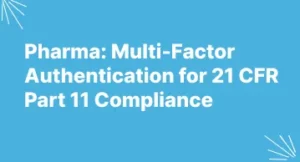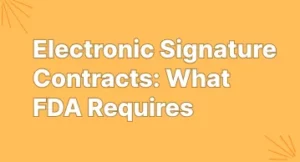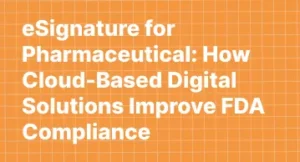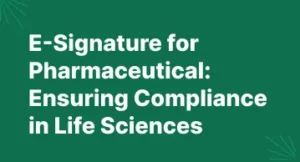Pharma: Steps to Conduct a Self-Assessment for 21 CFR Part 11 Readiness
Introduction
In the pharma industry, compliance with 21 CFR Part 11 is not optional—it’s a necessity. This regulation, established by the FDA, ensures that electronic records and electronic signatures meet strict security, integrity, and auditability requirements. But how can your organization ensure it is 21 CFR Part 11 compliant? The answer lies in a well-structured self-assessment.
Conducting a 21 CFR Part 11 readiness self-assessment helps identify compliance gaps, mitigate risks, and ensure regulatory adherence before facing FDA scrutiny. This guide outlines key steps for evaluating your electronic systems, vendor contract management , and data integrity protocols.
The FDA encourages a risk-based approach to 21 CFR Part 11 compliance—focusing resources and validation efforts on systems that directly impact product quality, patient safety, or data integrity. This mindset should guide your self-assessment process from start to finish.
Step 1: Understand the Scope of 21 CFR Part 11 Compliance
Before diving into the assessment, it’s important to determine whether 21 CFR Part 11 applies to your systems. Ask the following questions:
- Are you using electronic records instead of paper-based records?
- Do you rely on electronic signatures for approvals and authentication?
- Do you store or transmit electronic records that require FDA compliance?
If you answered yes to any of these, then 21 CFR Part 11 compliance is mandatory for your organization.
Step 2: Review Your Electronic Recordkeeping Practices
One of the core aspects of compliance is ensuring that electronic records are trustworthy and tamper-proof. Conduct a thorough audit of your current system by verifying:
- Data Integrity: Are records protected from unauthorized modifications?
- Audit Trails: Do you maintain a complete history of record changes?
- Access Controls: Are user roles defined, with restricted access to sensitive information?
If gaps exist, consider esignature solutions for pharma like MSB Docs, which offer secure digital recordkeeping tailored for regulated industries.
Step 3: Evaluate Electronic Signature Security
FDA regulations require that electronic signatures be legally binding and uniquely attributable to the signer. Your self-assessment should confirm that:
- Signatures are linked to individual users with unique IDs.
- There is a multi-factor authentication (MFA) process in place.
- Signed records cannot be altered without detection.
Using MSB Docs ensures compliance with 21 CFR Part 11 e-signature requirements, providing tamper-evident digital signatures .
Step 4: Assess Vendor Contract Management Practices
Many pharmaceutical companies rely on third-party vendors for electronic systems and cloud storage. However, vendor contract management must align with 21 CFR Part 11 requirements. Ensure that:
- Vendors provide documentation demonstrating system validation and compliance.
- Service agreements include compliance clauses.
- Vendors undergo regular audits to confirm security and integrity standards.
If your vendors do not meet these standards, it’s time to consider alternatives that prioritize regulatory compliance.
Step 5: Conduct a System Validation Audit
Validation is a critical component of 21 CFR Part 11 readiness. This step ensures that your electronic record and e-signature systems function reliably, securely, and as intended. Your assessment should focus on three core areas:
1. Validation Protocols & Evidence
- Software Validation: Have you documented validation protocols to collect objective evidence?
- Traceability : Is your validation traceable to user requirements and does it include installation, operational, and performance qualification (IQ/OQ/PQ) where applicable?
2. Ongoing Testing & Maintenance
- System Functionality: Does your system consistently operate as expected under real-world conditions?
- Regular Testing: Are periodic tests, revalidations, and change controls conducted to ensure continued compliance?
- Audit Trail Verification: Do your validation tests include audit trail and security feature verification?
3. Data Integrity Safeguards
- Backup & Recovery: Do you have documented, tested backup and disaster recovery procedures to protect electronic records from loss or corruption?
- System Decommissioning: When decommissioning systems or migrating data, do you follow procedures that maintain data integrity, traceability, and audit trails?
- Penetration Testing: Do you perform regular penetration testing or vulnerability assessments to identify and remediate security risks to electronic records and signature data?
Using an FDA-compliant solution like MSB Docs simplifies system validation and audit readiness.
Step 6: Implement Training & Standard Operating Procedures (SOPs)
Regulatory compliance is not just about technology—it also depends on people and processes. Your self-assessment should verify:
- Employees receive regular 21 CFR Part 11 compliance training .
- SOPs outline proper use of electronic records and e-signatures.
- A compliance officer is designated to oversee adherence to regulations.
By establishing well-documented SOPs , you can create a culture of compliance within your organization.
Step 7: Monitor and Continuously Improve Compliance
Regulatory expectations evolve, and so should your compliance strategy. After completing your self-assessment, focus on:
- Regular Internal Audits: Identify and correct compliance gaps.
- Continuous System Updates: Ensure software is up to date with FDA guidelines.
- Reviewing FDA Guidance: Stay informed about changing regulatory requirements.
Using e-signature for pharma solutions like MSB Docs provides continuous security updates and audit trail enhancements.
Conclusion
Conducting a self-assessment for 21 CFR Part 11 readiness is essential for pharmaceutical companies that rely on electronic records and e-signatures . By following these seven steps—understanding the scope, reviewing recordkeeping, evaluating signatures, assessing vendors, validating systems, implementing SOPs, and monitoring compliance—you can ensure that your organization is FDA-ready .
With solutions like MSB Docs, compliance becomes easier, offering secure, legally binding e-signatures and audit-ready electronic records. Start your self-assessment today to ensure regulatory success.







